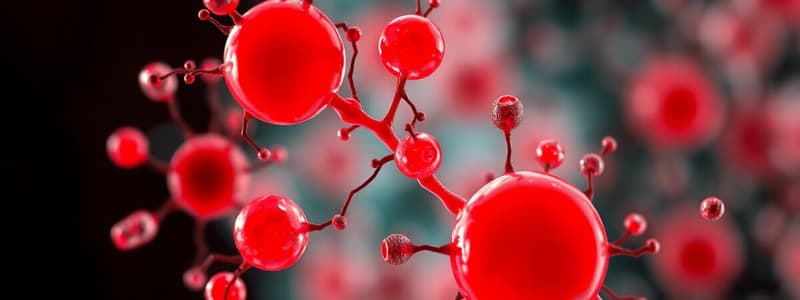Podcast
Questions and Answers
Which of the following is the MOST direct role of NADPH in protecting red blood cells from oxidative damage?
Which of the following is the MOST direct role of NADPH in protecting red blood cells from oxidative damage?
- Directly neutralizing superoxide radicals.
- Regenerating reduced glutathione. (correct)
- Catalyzing the breakdown of hydrogen peroxide.
- Preventing the formation of ROS from drugs.
What is the MOST accurate description of oxidative stress within a cell?
What is the MOST accurate description of oxidative stress within a cell?
- A decrease in reactive oxygen species (ROS) production.
- An increase in antioxidant enzyme production.
- An accumulation of oxidized proteins and lipids. (correct)
- A balance between ROS production and antioxidant mechanisms.
In red blood cells, reduced glutathione (G-SH) directly participates in which of the following processes?
In red blood cells, reduced glutathione (G-SH) directly participates in which of the following processes?
- Synthesis of hemoglobin.
- Reduction of oxidized glutathione (G-S-S-G).
- Elimination of hydrogen peroxide. (correct)
- Transport of oxygen.
A patient with G6PD deficiency experiences hemolytic anemia after taking a certain medication. What explains this phenomenon?
A patient with G6PD deficiency experiences hemolytic anemia after taking a certain medication. What explains this phenomenon?
Why is the glutathione system particularly important in red blood cells?
Why is the glutathione system particularly important in red blood cells?
Which of the following is a direct consequence of a deficiency in glucose-6-phosphate dehydrogenase (G6PD)?
Which of the following is a direct consequence of a deficiency in glucose-6-phosphate dehydrogenase (G6PD)?
A researcher is investigating the effects of a new drug on red blood cells. They observe an increased production of hydrogen peroxide (H2O2) within the cells. What compensatory mechanism would MOST likely be activated to counteract this effect?
A researcher is investigating the effects of a new drug on red blood cells. They observe an increased production of hydrogen peroxide (H2O2) within the cells. What compensatory mechanism would MOST likely be activated to counteract this effect?
A newborn is diagnosed with G6PD deficiency. What preventative advice is MOST crucial to provide to the parents?
A newborn is diagnosed with G6PD deficiency. What preventative advice is MOST crucial to provide to the parents?
How does the oxidation of proteins, specifically hemoglobin, contribute to the pathology observed in G6PD deficiency?
How does the oxidation of proteins, specifically hemoglobin, contribute to the pathology observed in G6PD deficiency?
If a patient with a history of hemolytic anemia after fava bean ingestion is suspected of having G6PD deficiency, which laboratory test would be MOST appropriate to confirm the diagnosis during an acute hemolytic episode?
If a patient with a history of hemolytic anemia after fava bean ingestion is suspected of having G6PD deficiency, which laboratory test would be MOST appropriate to confirm the diagnosis during an acute hemolytic episode?
Flashcards
Role of NADPH
Role of NADPH
NADPH is crucial for antioxidant mechanisms, particularly in reducing oxidative stress caused by reactive oxygen species (ROS).
Reactive Oxygen Species (ROS)
Reactive Oxygen Species (ROS)
ROS include superoxide, hydrogen peroxide (H2O2), and hydroxyl radicals, formed during normal metabolism and exposure to toxins.
Oxidative Stress
Oxidative Stress
Oxidative stress is an imbalance between the production of oxidants (ROS) and the body's antioxidant defense mechanisms.
Glutathione Function
Glutathione Function
Signup and view all the flashcards
G6PD Deficiency
G6PD Deficiency
Signup and view all the flashcards
Glutathione Peroxidase Role
Glutathione Peroxidase Role
Signup and view all the flashcards
Impact of G6PD Deficiency
Impact of G6PD Deficiency
Signup and view all the flashcards
Glutathione Redox Cycle
Glutathione Redox Cycle
Signup and view all the flashcards
H2O2 Production
H2O2 Production
Signup and view all the flashcards
Study Notes
- Glucose-6-phosphate dehydrogenase deficiency is discussed
- HMIM224 Block SEM 242 is specified in the document title
Objectives of the Lecture
- Identify the role of Nicotinamide adenine dinucleotide phosphate (NADPH) for antioxidant mechanisms
- Describe the genetic and biochemical basis of glucose-6-phosphate dehydrogenase deficiency (G6PD deficiency)
- Identify the clinical implication of G6PD deficiency in causing hemolytic anemia
- Recognize the precipitating factors for G6PD deficiency anemia
- Recall classes of G6PD deficiency anemia, indicated via variants of the G6P dehydrogenase enzyme
- Discuss the biochemical and clinical rationale for lines of diagnosis of G6PD deficiency anemia
Role of NADPH in Antioxidant Mechanisms
- The role of NADPH in antioxidant mechanisms diagram shows:
- Glucose-6-phosphate converting to 6-Phosphogluconolactone, which becomes 6-Phosphogluconate
- 6-Phosphogluconate then turns to Ribulose 5-phosphate
- Ribulose 5-phosphate becomes Ribose 5-phosphate
- Ribose 5-phosphate is used in Nucleotides, coenzymes, DNA, and RNA
- Glutathione reductase uses NADPH to become Glutathione, or 2GSH which converts to GSSG
Reactive Oxygen Species (ROS)
- Reactive Oxygen Species (ROS) refers to oxidants
- Superoxide, Hydrogen Peroxide (H2O2), and Hydroxyl Radical are examples of ROS
- ROS is formed continuously via aerobic metabolism of drugs and environmental toxins
- ROS cause oxidation of cellular components, such as the cell membrane (protein and lipid) and DNA
- ROS are implicated in hemolysis, cancer, chronic inflammatory disease, atherosclerosis, and aging
- Cells have protective mechanisms that minimize the toxic potential of ROS (antioxidant effect)
- Oxidative stress is an imbalance between oxidant production and the antioxidant mechanism
Antioxidants
- Enzymatic antioxidants include:
- Superoxide dismutase
- Catalase
- Glutathione peroxidase
- Glutathione reductase
- G6PD
- Non-enzymatic antioxidants include:
- Nutrient antioxidants (Acquired), such as Carotene (vit A), L-ascorbic acid (vit C), Tocopherol (vit E), and Selenium
- Metabolic antioxidants, such as glutathione, ceruloplasmin, albumin, bilirubin, transferrin, ferritin, and uric acid
Glutathione System
- Glucose converts to glucose-6-phosphate via hexokinase, then becomes 6-phospho-gluconate
- Glucose-6-phosphate uses G6PD in the process, G6PD turns glucose-6-phosphate to 6-phospho-gluconate
- NADP+ becomes NADPH as a result
- GSSG then converts to GSH and then to reactive oxygen species increases with oxidative factors
- Glutathione is needed in reduced form, which is important for:
- Eliminating hydrogen peroxide with a role in the survival of RBCs
- The protection of proteins SH to prevent oxidation of hemoglobin and cell membrane
Glucose 6-phosphate Dehydrogenase Deficiency
- G6PD Deficiency is inherited, leading to acute hemolytic anemia
- The deficiency arises from an inability to detoxify oxidized agents (ROS), causing damage to RBC membranes and cell lysis, or hemolysis
- G6PD is an X-linked recessive disease, where the G6PD gene is located on the X chromosome
- Affected males inherit the abnormal gene from their mothers, who are typically carriers, or heterozygotes
- G6PD deficiency is the most common enzyme-related hemolytic anemia
- This prevalence is especially recognized in the Middle East, Tropical Africa, Asia, and the Mediterranean
Biochemical Basis of G6PD Deficiency Hemolytic Anemia
- Glucose-6-phosphate dehydrogenase deficiency impairs the ability of an erythrocyte to form NADPH, leading to hemolysis
- Oxidant stress comes from certain drugs, infections, and fava beans
- H2O2 is generated normally in small amounts during normal red cell metabolism with larger amounts produced in infection or intake of an oxidant drug
- Reduced Glutathione (G-SH) reduces hydrogen peroxide (H2O2) by glutathione peroxidase
- Reduced glutathione is converted to oxidized glutathione (G-S-S-G)
- Oxidized glutathione is reduced again to reduced glutathione via glutathione reductase using NADPH
- NADPH is produced by Pentose Phosphate Pathway, the only source for it in RBCs
- Glucose 6-phosphate dehydrogenase (G6PD) is the first key enzyme in the pentose phosphate pathway ppp
- Diminished G6PD activity impairs the ability of the cell to form the NADPH that is essential for maintenance
- A decrease in the production of Reduced Glutathione results in a lessened detoxication of peroxides, which increases free radicals (ROS)
Additional Info on G6PD Deficiency
- The increase of free radicals cause damage the RBC membrane and cause hemolysis
- Hemoglobin protein is thus denatured, forming insoluble masses, or Heinz bodies
- Heinz bodies attach to red cell membranes and cause them to become rigid
- Rigid red cells are removed from circulation by macrophages in the spleen
- Splenic macrophages bite out the Heniz bodies, giving the bitten appearance of RBCs, or bite cells
G6PD Deficiency Precipitating Factors
- G6PD deficient patients develop hemolytic attack upon:
- Intake of oxidant drugs (AAA), such as antibiotics like sulf-methoxazole and chloramphenicol, antimalarials like Primaquine, and antipyretics like acetanilid
- Exposure to infection
- Ingestion of fava beans (favism, Mediterranean variant)
- Chronic nonspherocytic anemia:
- A hemolytic attack occurs in absence of precipitating factors, which leads to a severe form from class I mutation
- Favism:
- The hemolytic effect when ingesting fava beans is not observed everywhere with G6PD deficiency
- Patients generally do have G6PD deficiency when favism arises, predominantly from class II mutation
G6PD Variants
- There are 4 different classes with different enzyme activities:
- Class 1: severe enzyme deficiency <1% of normal activity, results in chronic hemolysis
- Class II: severe enzyme deficiency with <10% activity presents as intermittent hemolysis and is drug induced
- Class III: mild to moderate enzyme deficiency with 10-60% activity presents as intermittent hemolysis
- Class IV: very mild enzyme deficiency with 60-90% activity, resulting in little to no clinical problems
- Class V: very mild enzyme deficiency with >110% activity, resulting in little to no clinical problems
- Class 1: < 1% of normal, chronic
- Class II: < 10% of normal, intermittent
- G6PD Mediterranean is the severe form prominent in Caucasians
- Class III: 10-60% Normal, intermittent
- G6PD A- is observed here, where RBCs start with normal G6PD activity, which declines with age and is recognized often in Africa
- Class IV: Wild-type
- G6PD B is observed here
- Class V contains 2x normal activity
Diagnosis of G6PD Deficiency
- Symptoms are present when hemolytic anemia arises:
- Pallor
- Fatigue/weakness
- Tachycardia
- Jaundice
- Splenomegaly
- Dark, tea-colored urine, or hemoglobinuria
- Diagnosis of Hemolytic Anemia can be investigated via:
- CBC (complete blood count) and reticulocyte count, as well as a blood smear with special stain
- Screening is utilized via qualitative assessment of G6PD enzymatic activity, or fluorescent spot test
- This indicates the generation of NADPH from NADP
- Confirmatory tests are applied using quantitative measurement of G6PD enzymatic activity
- A molecular test is performed to identify detection of the G6PD gene mutation
Studying That Suits You
Use AI to generate personalized quizzes and flashcards to suit your learning preferences.




